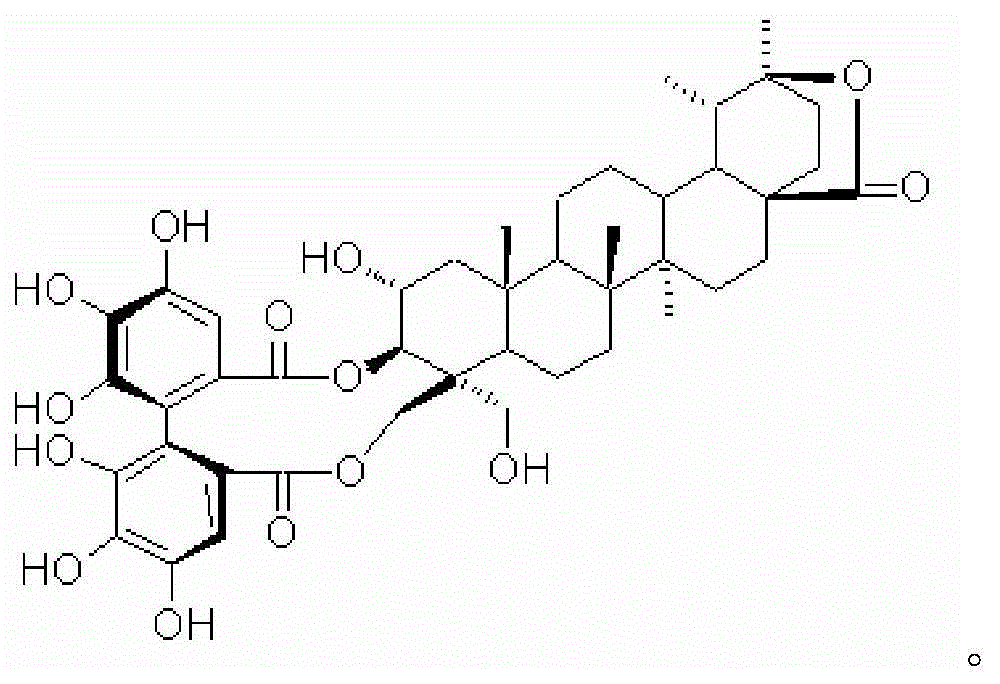Method of extracting and separating triterpenoid ellagitannin compound from castanopsis fissa leaves
A technology of triterpene ellagitan and pruriens, which is applied in the field of extraction of active ingredients in plants, can solve problems such as unsatisfactory yield, difficulty in industrialization, complicated process, etc., achieve simple operation, improve product yield and purity high effect
- Summary
- Abstract
- Description
- Claims
- Application Information
AI Technical Summary
Problems solved by technology
Method used
Image
Examples
Embodiment 1
[0021] 1) Take 6.0kg of fresh leaves of Mucuna pruriens, chop finely, add 80% acetone solution 5 times the weight of raw materials, extract at room temperature for 24 hours, filter, add 80% acetone solution 5 times the weight of raw materials to the filter residue, extract at room temperature for 12 hours, Filtrate and combine the filtrates to obtain the extract;
[0022] 2) When the extract is recovered from acetone under reduced pressure until complete, the chlorophyll and wax are removed by filtration to obtain the filtrate;
[0023] 3) Apply D101 macroporous resin chromatography to the filtrate obtained in step 2), wash the column with 4 times the resin volume of water, then elute with 4 times the resin volume of 50% ethanol, and then elute with 80% ethanol until there is no phenolic reaction (2wt% FeCl 3 For aqueous solution detection, the amount of 80% ethanol is about 7 times the volume of the resin), and the 80% ethanol eluate is collected;
[0024] 4) The collected ...
Embodiment 2
[0038] 1) Take 6.1 kg of fresh leaves of Mucuna pruriens, chop finely or pulverize, add 80% acetone solution 5 times the weight of the raw material, reflux extraction for 2 hours, filter, add 80% acetone solution 5 times the weight of the raw material to the filter residue, and reflux extraction for 2 hours, Filtrate and combine the filtrates to obtain the extract;
[0039] 2) When the extract is recovered from acetone under reduced pressure until complete, the chlorophyll and wax are removed by filtration to obtain the filtrate;
[0040] 3) HP-20 macroporous resin chromatography on the filtrate obtained in step 2), wash the column with water of 4 times the volume of the resin, then elute with 30% ethanol of 4 times the volume of the resin, and then elute with 90% ethanol until no phenol Sexual reaction (2wt% FeCl 3 For aqueous solution detection, the amount of 90% ethanol is about 6 times the volume of the resin), and the 90% ethanol eluate is collected;
[0041] 4) Concent...
Embodiment 3
[0043] 1) Take 6.5 kg of fresh leaves of Mucuna pruriens, chop finely, add 90% acetone solution 10 times the weight of the raw material, extract at room temperature for 24 hours, filter, add 90% acetone solution 5 times the weight of the raw material to the filter residue, extract at room temperature for 10 hours, Filtrate and combine the filtrates to obtain the extract;
[0044] 2) When the extract is recovered from acetone under reduced pressure until complete, the chlorophyll and wax are removed by filtration to obtain the filtrate;
[0045] 3) Apply D-4020 macroporous resin chromatography to the filtrate obtained in step 2), wash the column with 6 times the volume of the resin, then elute with 50% methanol of 5 times the volume of the resin, and then elute with 80% methanol until no phenol Sexual reaction (2wt% FeCl 3 For aqueous solution detection, the amount of 80% methanol used is about 7 times the volume of the resin), and the 80% methanol eluate is collected;
[004...
PUM
 Login to View More
Login to View More Abstract
Description
Claims
Application Information
 Login to View More
Login to View More - R&D
- Intellectual Property
- Life Sciences
- Materials
- Tech Scout
- Unparalleled Data Quality
- Higher Quality Content
- 60% Fewer Hallucinations
Browse by: Latest US Patents, China's latest patents, Technical Efficacy Thesaurus, Application Domain, Technology Topic, Popular Technical Reports.
© 2025 PatSnap. All rights reserved.Legal|Privacy policy|Modern Slavery Act Transparency Statement|Sitemap|About US| Contact US: help@patsnap.com



